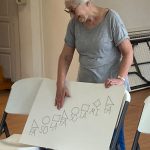Old-time practice of shape-note singing finds adherents today
 Brad Hundt/Observer-Reporter
Brad Hundt/Observer-Reporter
PITTSBURGH – Alexa Kay is a Quaker, a denomination which has embraced simplicity and shunned more extravagant forms of worship, even singing.
Nevertheless, Kay likes to sing, and that’s what led her to the Church of the Redeemer in Squirrel Hill on a sweltering Saturday afternoon earlier this month. Kay was there with almost 20 other people to indulge in a couple of hours of shape-note singing.
“This fills the congregational singing hole in my heart,” Kay explained.
But just what is shape-note singing?
Arguably, it can be classified as being part of what cultural critic Greil Marcus has described as “the old, weird America.” To be sure, shape-note singing can seem archaic and eccentric to contemporary sensibilities. It came into being in New England in the late 1700s as a way to get reluctant, untrained singers in churches to raise their voices and sing during worship services. To accomplish this, a simpler form of musical notation was adopted, where each note has a different geometrical shape. Those shapes represent different pitches, making it easier for casual singers to sight read.
At its inception, shape-note singing had just four notes – fa, so, la and mi – with “fa” represented through a triangle, “so” with a circle, “la” with a square and “mi” with a diamond.
Historian and musician Guy Logsdon describes it this way in an essay for the Oklahoma Historical Society: “A song leader could easily learn a melody by reading the shapes and singing the appropriate tones. Shape-note singing proved useful among Protestant denominations that frowned on the use of musical instruments…”
Logsdon continued, “Itinerant teachers traveled from county to county, teaching in the evening, when people could congregate.” From there, “as people learned the method and the melodies and sang together, group harmonic singing became popular.”
Though shape-note singing faded away in New England, it gained a foothold in the rural South and through Appalachia and was rediscovered in the 1960s folk music revival. It’s being kept alive today through local groups like the one in Pittsburgh, and others in places like Lancaster, Morgantown, W.Va., and Louisville, Ky. An abundance of shape-note recordings can also be heard on discs and online, some of them dating back to the 1920s.
The Pittsburgh group is led by Penny Anderson, a Wilkinsburg resident and retired computer science teacher. She first became fascinated with shape-note singing in the 1980s, saying it offered relief from the stresses of graduate school. Anderson pointed out that shape-note singing isn’t really meant to be performed, but is more for the enjoyment of its participants.
“The main thing that drew me to shape-note singing is the social purpose of it,” she explained. “It’s not performance music at all. The purpose of it is to be together. We sing for ourselves and each other.”
At the shape-note singing sessions that Anderson leads, chairs are arranged in a square formation, so the singers face one another rather than visitors. Anderson, as the group’s leader, stands in the center and moves her arm up and down in a form of what she describes as “folk conducting.”
“It keeps things moving and helps people remain oriented while sight reading,” she said.
Another regular participant in the Pittsburgh shape-note singing sessions is Washington attorney Jack Puskar. His interest in shape-note singing began when he was in college in the 1990s, and he emphasized how the sound of it “hasn’t changed in 100 years.”
Puskar also said, to the untrained ear, shape-note singing can sound “a bit harsh.”
“It’s raw,” he explained. “It’s gripping.”
Shape-note singers like Puskar will bring their own copies of “The Sacred Harp” with them to get-togethers. “The Sacred Harp” is a collection of shape-note hymns, sacred songs and odes dating back to the 1840s. It adds to the sense of peculiarity that surrounds shape-note singing since many songs in “The Sacred Harp” carry titles that have nothing to do with the lyrics themselves. A selection called “Cuba,” for example, doesn’t mention the Caribbean island at all, and is instead about how “through free grace and a dying lamb, poor mourners found a home last.”
Other titles that can be found in “The Sacred Harp” are “Fillmore,” “Elder,” “Bristol,” “Lisbon,” “Mulberry Grove,” “New Agatite” and “Haynes Creek.” A new edition of “The Sacred Harp” – the first in 34 years – is due to be unveiled in September at the annual gathering of the United Sacred Harp Musical Association in Atlanta.
Vic Spindler-Fox looked at a copy of “The Sacred Harp” at the get-together at the Church of the Redeemer while singing and holding Micah, her 6-month-old daughter. Spindler-Fox recounted how she first became intrigued by shape-note singing when she and her husband, Troy, were taking a stroll by the building.
“We heard it on the sidewalk and came in,” she said. “It’s set up to let people join.”
Spindler-Fox is relatively new to shape-note singing, but she was seated next to Frances Mary D’Andrea, who, in her words “has been doing it for decades.” She joined a shape-note singing group when she lived in Atlanta in the early 1990s, and her interest continued when she and her family moved to Pittsburgh.
“The sound is so visceral,” she said. “When we moved to Atlanta, I couldn’t believe people were still doing it.”
The Pittsburgh shape-note singing group usually meets on the first Saturday of the month at 1 p.m. Information can be found at https://calliopehouse.org/event/shape-note-sing/. Archival recordings of shape-note singing can be found at https://www.youtube.com/watch?v=wgUwnxqXmQY.

